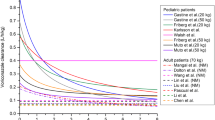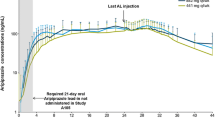Abstract
Background and Objectives
Loxapine for inhalation is a drug-device combination product approved in adults for the acute treatment of agitation associated with schizophrenia or bipolar I disorder. The primary objective of this study was to develop a clinical trial protocol to support a phase I pharmacokinetic study in children aged 10 years and older. In addition, this report details the results of the clinical study in relation to the predicted likelihood of achieving the target exposure associated with therapeutic effect in adults.
Methods
A nonlinear mixed-effects population pharmacokinetic model was developed using adult data and was adjusted for the targeted pediatric age groups by applying allometric scaling to account for body size effects. Based on this pediatric model, age-appropriate regimens to achieve loxapine exposures similar to the ones associated with therapeutic effect in the adult studies were identified via trial simulation. D-optimal design and power analysis were conducted to identify optimal pharmacokinetic sampling times and sample size, respectively.
Results
The developed clinical trial design formed the basis of a phase I study to assess the safety and pharmacokinetics of loxapine for inhalation in children aged 10 years and older (ClinicalTrials.gov ID: NCT02184767).
Conclusion
The results of the study indicated that overall loxapine exposures were consistent with what had been predicted by the trial simulations. The presented approach illustrates how modeling and simulation can assist in the design of informative clinical trials to identify safe and effective doses and dose ranges in children and adolescents.





Similar content being viewed by others
References
Adasuve [package insert]. Horsham (PA). USA: Teva Pharmaceuticals; 2013.
Heel RC, Brogden RN, Speight TM, Avery GS. Loxapine: a review of its pharmacological properties and therapeutic efficacy as an antipsychotic agent. Drugs. 1978;15(3):198–217.
Dinh K, Myers DJ, Glazer M, et al. In vitro aerosol characterization of Staccato® Loxapine. Int J Pharm. 2011;403(1–2):101–8.
Allen MH, Feifel D, Lesem MD, et al. Efficacy and safety of loxapine for inhalation in the treatment of agitation in patients with schizophrenia: a randomized, double-blind, placebo-controlled trial. J Clin Psychiatry. 2011;72(10):1313–21.
Lesem MD, Tran-Johnson TK, Riesenberg RA, et al. Rapid acute treatment of agitation in individuals with schizophrenia: multicentre, randomised, placebo-controlled study of inhaled loxapine. Br J Psychiatry. 2011;198(1):51–8.
Kwentus J, Riesenberg RA, Marandi M, et al. Rapid acute treatment of agitation in patients with bipolar I disorder: a multicenter, randomized, placebo-controlled clinical trial with inhaled loxapine. Bipolar Disord. 2012;14(1):31–40.
Geller B, Luby J. Child and adolescent bipolar disorder: a review of the past 10 years. J Am Acad Child Adolesc Psychiatry. 1997;36(9):1168–76.
Hafner H, Nowotny B. Epidemiology of early-onset schizophrenia. Eur Arch Psychiatry Clin Neurosci. 1995;245(2):80–92.
Hellings JA, Reed G, Cain SE, et al. Loxapine add-on for adolescents and adults with autism spectrum disorders and irritability. J Child Adolesc Psychopharmacol. 2015;25(2):150–9.
Reinblatt SP, Abanilla PK, Jummani R, Coffey B. Loxapine treatment in an autistic child with aggressive behavior: therapeutic challenges. J Child Adolesc Psychopharmacol. 2006;16(5):639–43.
Spyker DA, Munzar P, Cassella JV. Pharmacokinetics of loxapine following inhalation of a thermally generated aerosol in healthy volunteers. J Clin Pharmacol. 2010;50(2):169–79.
Luo JP, Vashishtha SC, Hawes EM, et al. In vitro identification of the human cytochrome p450 enzymes involved in the oxidative metabolism of loxapine. Biopharm Drug Dispos. 2011;32(7):398–407.
Midha KK, Hubbard JW, McKay G, et al. The role of metabolites in a bioequivalence study 1: loxapine, 7-hydroxyloxapine and 8-hydroxyloxapine. Int J Clin Pharmacol Ther Toxicol. 1993;31(4):177–83.
Takahashi LH, Huie K, Spyker DA, et al. Effect of smoking on the pharmacokinetics of inhaled loxapine. Ther Drug Monit. 2014;36(5):618–23.
Zimmer JS, Needham SR, Christianson CD, et al. Validation of HPLC-MS/MS methods for analysis of loxapine, amoxapine, 7-OH-loxapine, 8-OH-loxapine and loxapine N-oxide in human plasma. Bioanalysis. 2010;2(12):1989–2000.
Beal S, Sheiner LB, Boeckmann A, Bauer RJ. NONMEM user’s guide (1989–2009). Ellicott City (MO): ICON Development Solutions; 2009.
Savic RM, Karlsson MO. Importance of shrinkage in empirical bayes estimates for diagnostics: problems and solutions. AAPS J. 2009;11(3):558–69.
Jonsson EN, Karlsson MO. Xpose: an S-PLUS based population pharmacokinetic/pharmacodynamic model building aid for NONMEM. Comput Methods Programs Biomed. 1999;58(1):51–64.
Dong M, McGann PT, Mizuno T, et al. Development of a pharmacokinetic-guided dose individualization strategy for hydroxyurea treatment in children with sickle cell anaemia. Br J Clin Pharmacol. 2016;81(4):742–52.
Mould DR, Upton RN. Basic concepts in population modeling, simulation, and model-based drug development-part 2: introduction to pharmacokinetic modeling methods. CPT Pharmacometrics Syst Pharmacol. 2013;2:e38.
Punyawudho B, Ramsay ER, Brundage RC, et al. Population pharmacokinetics of carbamazepine in elderly patients. Ther Drug Monit. 2012;34(2):176–81.
Holford N. The visual predictive check: superiority to standard diagnostic (Rorschach) plots [abstract no. 738]. Annual Meeting of the Population Approach Group in Europe; 16–17 Jun 2005; Pamplona, Spain.
Keizer RJ, Karlsson MO, Hooker A. Modeling and simulation workbench for NONMEM: tutorial on Pirana, PsN, and Xpose. CPT Pharmacometrics Syst Pharmacol. 2013;2:e50.
Anderson BJ, Holford NH. Tips and traps analyzing pediatric PK data. Paediatr Anaesth. 2011;21(3):222–37.
Vinks AA, Emoto C, Fukuda T. Modeling and simulation in pediatric drug therapy: application of pharmacometrics to define the right dose for children. Clin Pharmacol Ther. 2015;98(3):298–308.
Anderson BJ, Allegaert K, Holford NH. Population clinical pharmacology of children: modelling covariate effects. Eur J Pediatr. 2006;165(12):819–29.
Calvier EA, Krekels EH, Valitalo PA, et al. Allometric scaling of clearance in paediatric patients: when does the magic of 0.75 fade? Clin Pharmacokinet. 2016. doi:10.1007/s40262-016-0436-x. [Epub ahead of print].
Liu T, Ghafoori P, Gobburu JV. Allometry is a reasonable choice in pediatric drug development. J Clin Pharmacol. doi:10.1002/jcph.831. [Epub ahead of print].
Edginton AN, Shah B, Sevestre M, Momper JD. The integration of allometry and virtual populations to predict clearance and clearance variability in pediatric populations over the age of 6 years. Clin Pharmacokinet. 2013;52(8):693–703.
Kolokotrones T, Van S, Deeds EJ, Fontana W. Curvature in metabolic scaling. Nature. 2010;464(7289):753–6.
Krekels EH, van Hasselt JG, Tibboel D, et al. Systematic evaluation of the descriptive and predictive performance of paediatric morphine population models. Pharm Res. 2011;28(4):797–811.
Mahmood I. Pharmacokinetic allometric scaling of antibodies: application to the first-in-human dose estimation. J Pharm Sci. 2009;98(10):3850–61.
Dunne J, Rodriguez WJ, Murphy MD, et al. Extrapolation of adult data and other data in pediatric drug-development programs. Pediatrics. 2011;128(5):e1242–9.
Bergsma TT, Knebel W, Fisher J, et al. Facilitating pharmacometric workflow with the metrumrg package for R. Comput Methods Programs Biomed. 2013;109(1):77–85.
Duffull S, Denman N, Eccleston J, Kimko H. WinPOPT (version 1.2) user guide. Dunedin: School of Pharmacy, University of Otago; 2008.
Wang Y, Jadhav PR, Lala M, Gobburu JV. Clarification on precision criteria to derive sample size when designing pediatric pharmacokinetic studies. J Clin Pharmacol. 2012;52(10):1601–6.
D’Hondt E, Deforche B, Gentier I, et al. A longitudinal analysis of gross motor coordination in overweight and obese children versus normal-weight peers. Int J Obes (Lond). 2013;37(1):61–7.
Damme TV, Simons J, Sabbe B, van West D. Motor abilities of children and adolescents with a psychiatric condition: a systematic literature review. World J Psychiatry. 2015;5(3):315–29.
Acknowledgements
We are grateful to Drs. Michael Sorter and Drew Barzman of the Division of Child and Adolescent Psychiatry at Cincinnati Children’s Hospital Medical Center, Cincinnati, OH, USA for sharing the age-weight data that were used in the external model validation.
Author information
Authors and Affiliations
Corresponding author
Ethics declarations
Funding
This study was sponsored by Teva Branded Pharmaceutical Products R & D, Inc. and Alexza Pharmaceuticals. Both companies reviewed and approved the manuscript. Editorial assistance was provided by Peloton Advantage and was funded by Teva Branded Pharmaceutical Products R & D, Inc. (Frazer, PA, USA).
Conflict of interest
Min Dong has received a National Institute of Child Health and Human Development training grant (5T32HD069054) and is an employee of Cincinnati Children’s Hospital Medical Center, Cincinnati, OH, USA. Tsuyoshi Fukuda declares that he has no conflict of interest. Sally Selim and Laura Rabinovich-Guilatt are employees of Teva Pharmaceuticals and may hold stock/stock options in that company. Mark A. Smith was an employee of Teva Pharmaceuticals at the time of study conduct. James V. Cassella was an employee of Alexza Pharmaceuticals at the time of study design and conduct, and received consulting fees from Alexza Pharmaceuticals during manuscript review. Alexander A. Vinks has been a consultant for the study sponsor through a consulting agreement between Teva Pharmaceuticals and Cincinnati Children’s Hospital Medical Center, Cincinnati, OH, USA.
Ethics approval
This article does not contain any studies with human participants or animals performed by any of the authors.
Electronic supplementary material
Below is the link to the electronic supplementary material.
Rights and permissions
About this article
Cite this article
Dong, M., Fukuda, T., Selim, S. et al. Clinical Trial Simulations and Pharmacometric Analysis in Pediatrics: Application to Inhaled Loxapine in Children and Adolescents. Clin Pharmacokinet 56, 1207–1217 (2017). https://doi.org/10.1007/s40262-017-0512-x
Published:
Issue Date:
DOI: https://doi.org/10.1007/s40262-017-0512-x




